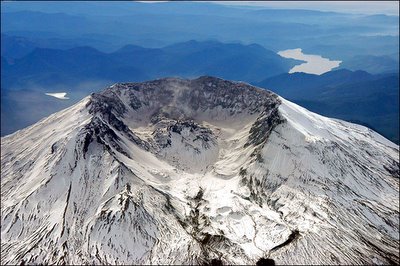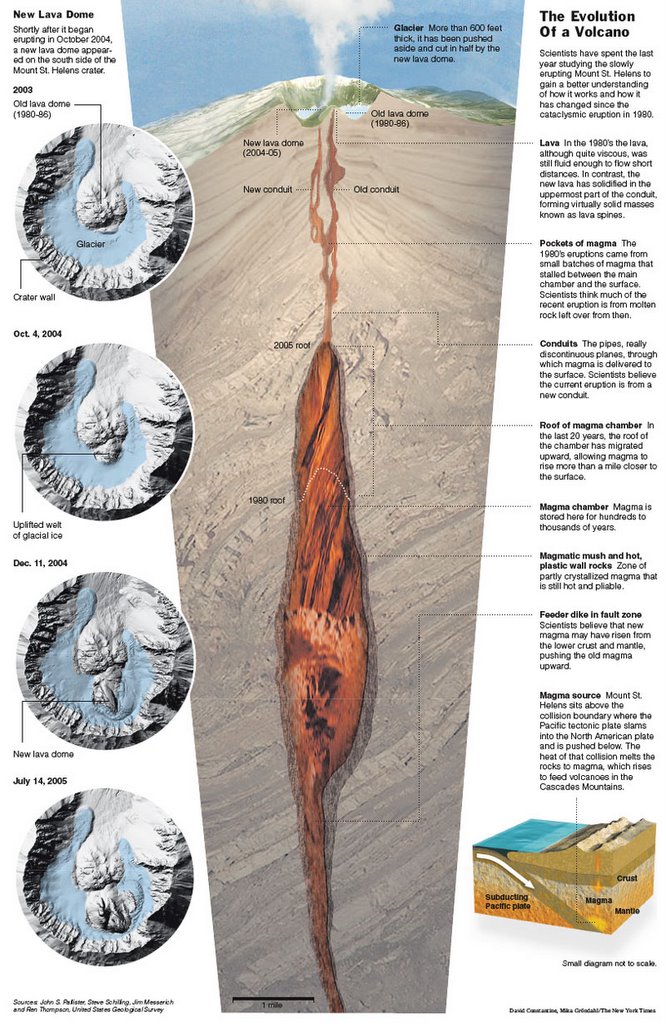Mount St. Helens of Glass
"Each second," the New York Times reports, "about a cubic yard of new mountain—roughly a pickup truck's worth—is pushed to the surface [of Mount St. Helens], adding to a dome growing inside the crater." Each second.
 [Image: "Mount St. Helens, its second dome visible, is being shaken constantly by earthquakes." John S. Pallister/USGS Cascades Volcano Observatory/New York Times].
[Image: "Mount St. Helens, its second dome visible, is being shaken constantly by earthquakes." John S. Pallister/USGS Cascades Volcano Observatory/New York Times].
The mountain, it seems, as evidenced by a recent and ongoing series of minor earthquakes, is undergoing a slow, quiet eruption. "Beneath the mountain," we read, "the magma rises through fractures in the rock from a fairly small magma chamber about five miles below. Beneath that chamber is probably another pipe that taps the deeper mantle."
Those fractures and pipes look something like this:
 [Image: New York Times; this diagram kicks ass at a larger size].
[Image: New York Times; this diagram kicks ass at a larger size].
Further, "As the current eruption empties the conduit, scientists have detected a slight deflation of the flanks of the volcano, though not quite as much as predicted, which suggests that the chamber has partially been refilled by new magma."
The insane thing here is that one of the scientists profiled in this article knows that the magma chambers are refilling because he has found fresh glass on the mountainside. I can't help but wonder if, at any phase of the earth's history, there might have been whole mountain chains made entirely of glass, translucent, marbled, veined with stained metals and colored by minerals, like cathedral windows in mountain form—
 [Image: ArtLex].
[Image: ArtLex].
—that would would have fractalized sunset into angles and shards, the horizon ablaze. Mountains, shining from within.
Whole islands emerge from the Pacific, made of translucent colored glass. You can watch fish through them. Comets reflect in ripples across their smoothly ridged surfaces. A minor earthquake makes the planet ring like a fragile glass bell.
What species could evolve on glass islands? What would they eat? What would riverbeds look like, and could you watch streams from below?
Could you watch treeroots pop slowly, expanding through layers of bedglass? Glass tectonics. The mountains are literally shattering from below.
Or imagine Shelley, arriving by ship at a tropical archipelago made of glass. Thousands of small islands, and he sails between each one. He soon begins a series of epic poems to be published exclusively on BLDGBLOG, inspired by a moonlit tour of ruined glass arches shaped by natural erosion. He carves a cup directly from the mountain and he drinks wine with it. The earth breaks down into transparent soil.
Anyway, the New York Times article also includes this photographic demonstration of the volcanic dome's growth. I guess I just like volcanoes...
 [Image: "Mount St. Helens, its second dome visible, is being shaken constantly by earthquakes." John S. Pallister/USGS Cascades Volcano Observatory/New York Times].
[Image: "Mount St. Helens, its second dome visible, is being shaken constantly by earthquakes." John S. Pallister/USGS Cascades Volcano Observatory/New York Times].The mountain, it seems, as evidenced by a recent and ongoing series of minor earthquakes, is undergoing a slow, quiet eruption. "Beneath the mountain," we read, "the magma rises through fractures in the rock from a fairly small magma chamber about five miles below. Beneath that chamber is probably another pipe that taps the deeper mantle."
Those fractures and pipes look something like this:
 [Image: New York Times; this diagram kicks ass at a larger size].
[Image: New York Times; this diagram kicks ass at a larger size].Further, "As the current eruption empties the conduit, scientists have detected a slight deflation of the flanks of the volcano, though not quite as much as predicted, which suggests that the chamber has partially been refilled by new magma."
The insane thing here is that one of the scientists profiled in this article knows that the magma chambers are refilling because he has found fresh glass on the mountainside. I can't help but wonder if, at any phase of the earth's history, there might have been whole mountain chains made entirely of glass, translucent, marbled, veined with stained metals and colored by minerals, like cathedral windows in mountain form—
 [Image: ArtLex].
[Image: ArtLex].—that would would have fractalized sunset into angles and shards, the horizon ablaze. Mountains, shining from within.
Whole islands emerge from the Pacific, made of translucent colored glass. You can watch fish through them. Comets reflect in ripples across their smoothly ridged surfaces. A minor earthquake makes the planet ring like a fragile glass bell.
What species could evolve on glass islands? What would they eat? What would riverbeds look like, and could you watch streams from below?
Could you watch treeroots pop slowly, expanding through layers of bedglass? Glass tectonics. The mountains are literally shattering from below.
Or imagine Shelley, arriving by ship at a tropical archipelago made of glass. Thousands of small islands, and he sails between each one. He soon begins a series of epic poems to be published exclusively on BLDGBLOG, inspired by a moonlit tour of ruined glass arches shaped by natural erosion. He carves a cup directly from the mountain and he drinks wine with it. The earth breaks down into transparent soil.
Anyway, the New York Times article also includes this photographic demonstration of the volcanic dome's growth. I guess I just like volcanoes...

Comments are moderated.
If it's not spam, it will appear here shortly!
As cool as that image may be, the glass would be REALLY dirty, and hard to see through. impurities would exist in the glass, as carbon deposits most likly.
yeah, it would shine pretty bright in the sunlight, and be a magnificent sight to behold, but I doubt you could see through it.
The other issue is that geological stresses would shatter it pretty quick, which is why we probably see glass from volcanos as small chunks, not as huge segments of the mountain.
Mt St Helens is one of the most amazing things I've ever seen in my life, I highly suggest going to visit it, the sooner the better as it seems to be threatening a major erruption.
What is this site? Found this throught the Scientologist thing! Travolta on Mt. Saint Helens - LOL
The USGS Geographic Names Information System lists nine places called 'Glass Mountain'. I've been to two of them - the obsidian is black and opaque. Still very cool.
-Jef (blogger login not working)
Hey Jef - Sorry about the log-in, it might be the scientology post, which has had more than twenty thousand visitors in the last 12 hours. So the page might be slow. Or not, who knows. (20,000 people???).
Anyway, I refrained from referring to "obsidian mountains" because I know you'd never see a thing through it! And because it would've sounded like a short story by H.P. Lovecraft. But a semi-translucent glass lump being extruded from the earth in volcanic rivers...! Or a tropical archipelago made entirely of glass islands...! Just seemed like too beautiful an image to pass up. And, Duran, same thing - I know it's totally unfeasible - but I'd still like to see it! Huge faultlines of glass, or glass - like windows - billowing up at midocean rifts. Instantly freezing into weird amorphic knots and floating around in the darkness. And I'd love to visit St. Helens.
As for Travolta on Mount St. Helens - good luck to him.
Oh, and anyone into magma should check out the final chapter in John McPhee's The Control of Nature, there's an Amazon link to it in the right-hand column ------------------------>
Check it out, it's an insane book, and a great chapter.
The link to the McPhee book is under "Some Good Books," over there ----------------> in the right column, if you scroll down a bit - Also, his Annals of the Former World is fucking great!
I love Mount St. Helens. =)
I am doing a geography project on Mount St. Helens and I have learned some really cool stuff! It's really interesting! :)
Post a Comment